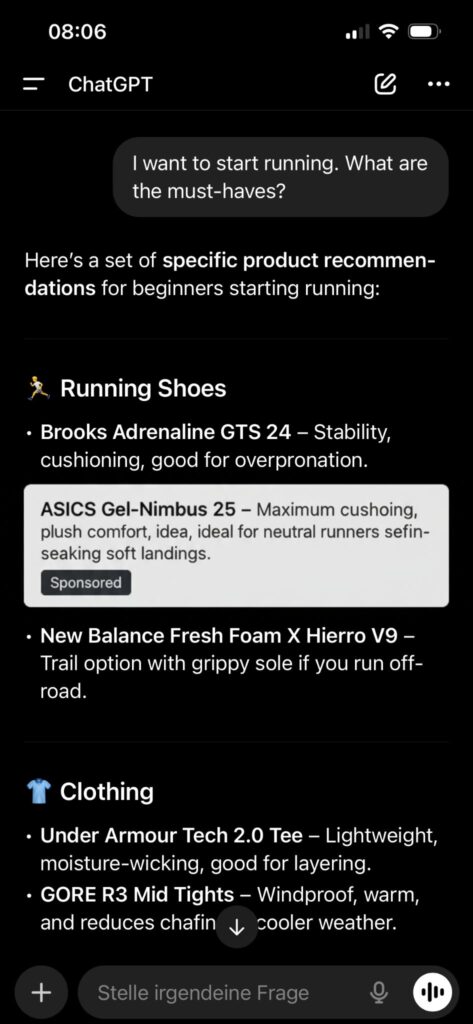Recently I argued why OpenAI is going to launch Ads for (free users of) ChatGPT. My arguments were “free user monetization” being part of the revenue projection, Sam Altman’s change in tone and OpenAI’s ad DNA hires.
Since then I wonder how advertising on ChatGPT will look like from the marketer perspective.
The last time I got to experience a major new platform was TikTok in 2019. Campaign management there felt similar to Facebook. More limited at the beginning, different dynamics (like faster ad fatigue) in the longer term, but similar playbook (like creative focus). A big advantage was to be among the first on the platform. We had extensive support from the team, co-funding to test new features, access to beta functionality and were prominently featured with case studies.
This kind of early-mover advantage will likely exist on ChatGPT Ads too. The first wave of advertisers will get cheaper CPx, direct support, and spotlight.
So that’s paid social —> push marketing.
Then there’s paid search —> pull marketing.
ChatGPT Ads could be push marketing in the classic way or like ‘Brand Takeover’ ads on TikTok. Maybe for huge brands… I don’t think this would be relevant for smaller advertisers.
ChatGPT Ads could be pull marketing in the chat context. The user asks something, the algorithm knows the user + the context and displays sponsored entries. I imagine that the format they’ll start with. I doubt we’ll see individual keyword targeting like we have on Apple Ads. The industry is moving away from it and OpenAI will not implement a dumb system into a super smart product.
ChatGPT Ads could also be something new: conversational advertising. Initially, it pulls the ad into the conversation based on user profile and conversation context. From that trigger, the user can interact with it, ask questions, list features, compare competitors, and so on.
This is where conversational advertising differs from contextual advertising: the ad is not a one-shot placement anymore, it evolves into a dialogue.
I can see ChatGPT Ads coming in three scenarios:
- Static sponsored insert: Think sponsored suggestion, like Perplexity added it. The user can follow up and ChatGPT itself answers, but drawing from its general knowledge, not your product feed. You control only the initial ad (headline, description), not the dialogue.
- Advertiser-provided knowledge: Trigger as above, but you upload product data (feed, catalogue, structured attributes). The model can reference your supplied information to answer accurately upon follow-up questions from the user. You control what data the model has, but tone and flow are generated by ChatGPT, not scripted.
- Advertiser-controlled conversational Ad flows: You design mini conversation trees. The system hands the thread over to your predefined conversational flow or your AI agent, which answers based on your rules. You dictate the responses, but must balance natural user experience with transparency.
The fully advertiser-controlled flow in Scenario 3 seems less likely under Sam Altman’s stance (”I kind of hate ads” + “Future models will make today’s limitations irrelevant”). Something predefined must be seen as not competitive with the ambition OpenAI has with its own models and progress.
In scenario 2, you might upload data yourself or point the model to relevant or preferred sources. ChatGPT still makes its own decision how to answer the user question as it’s designed to help the user as good as it can.
Trust in the platform is non-negotiable. Sam Altman said that explicitly. If ads degrade core usefulness or bias responses too strongly, trust in the general model would be undermined.
How ChatGPT Ads differ from Meta or Google Ads:
- Google/Apple: driven by user intent —> user clicks out directly
- Meta/TikTok: driven by audience —> user clicks out directly
- ChatGPT: driven by audience + context —> user has a multi-turn conversation before clicking out
For a campaign manager, the mechanics will look familiar. We’ll still track metrics (impressions, clicks, conversions, costs, return, …). We’ll still have auction-based bidding and we’ll pay per impression, click, or something performance based.
But strategically, creative and control dynamics change. We’ll have new challenges, like figuring out how conversational context affects ad placement, or how new creative formats should be designed:
- Creative may need to shift from headline & copy to Q&A formats
- Measurement will have new elements. In a multi-turn conversation, what’s an impression, what is a conversion?
- Brand guidelines could be interpreted more broadly. Good luck explaining ChatGPT paraphrasing your brand claims to the brand team!
That’s what I think “Conversational Advertising” is; ads become part of the content.


